I tried playing 'Catan Energy Edition,' which adds elements such as environmental pollution to the 'Catan' game and improves the cooperative element.

' Catan ' is a popular classic board game that was released in Germany in 1995 and has won many prestigious board game awards, including the German Game of the Year Award and the German Game Award. On December 13, 2024, ' Catan Energy Edition ,' which is based on 'Catan' and adds elements such as environmental pollution, will be released. This time, I had the opportunity to borrow and play the game ahead of its release, so I actually played it.
Catan Energy Edition
The package for the 'Catan Energy Edition' looks like this. The first-run limited edition comes with an expansion kit.

The recommended age is 12 years and over, the number of players is 3 to 4, and the estimated playing time is 90 minutes.

The contents are as follows: 6 sea frames, 19 terrain tiles, 18 number chips, 2 special victory point tiles, 4 warehouse tiles, 10 environmental destruction markers, 36 green event chips, and 43 brown event chips.

The pieces used by players are divided into four colors: 20 village pieces (5 of each color), 16 research city pieces (4 of each color), 48 road pieces (12 of each color), and 4 victory point markers (1 of each color). In addition, there are 36 green power plant pieces, 24 brown power plant pieces, 2 dice, 20 energy pieces, and 1 bag for event chips.

The set contains a wide range of content, including four piece holders to assemble and use, 20 research cards, 95 resource cards, three event summary cards, 25 development cards, and four personal boards.

The terrain tiles on Catan Island are of six types: forest, hill, pasture, field, mine, and desert, the same as the base game, Catan.

There are five types of resource cards: 'wood,' 'brick,' 'natural fiber,' 'food,' and 'metal,' and the background of the card indicates the corresponding terrain tile. During the game, these resources are produced from the corresponding terrain tile.

There are five types of development cards: '1 victory point', 'Subsidy', 'Road construction', 'Performance improvement', and 'Environmental protection'. By using these cards effectively, you can advance the game to your advantage.

There are five types of brown event chips: 'Climate Conference,' 'Increased Production,' 'Air Pollution,' 'Heavy Rain and Floods,' and 'Environmental Disasters.' The occurrence of these events will lead to environmental pollution on the island of Catan.

Before starting the game, put brown event chips into the bag.

There are three types of green event chips that have a positive impact on the environment: 'Climate Conference,' 'Sustainable Production,' and 'Government Aid.'

The following are the 'research city pieces', 'village pieces', and 'road pieces' that correspond to 'cities', 'settlements', and 'roads' in the original Catan. In addition, the 'environmental investigator piece' is a piece that corresponds to the 'thief piece' in the base Catan.

Two special victory point tiles are also included from Catan: 'Longest Trade Route' and 'Environmental Activities Award.'

Let's play 'Catan Energy Edition' with four people. First, use the sea frame to create the outer frame of Catan Island, the setting of the game.
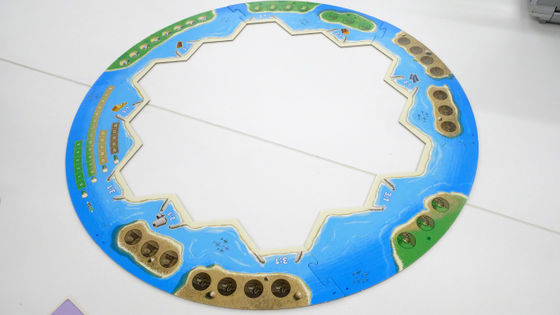
Normally, you place the terrain tiles, initial research city pieces, and village pieces randomly, but this time, the initial placement for 'first-time players' was listed in the instruction manual, so I arranged them exactly as described. In addition to separating the resource cards and research cards by type and placing them in card holders next to the board, you also place the special victory point tiles, event summary cards, energy pieces, environmental destruction markers, and dice next to the board.
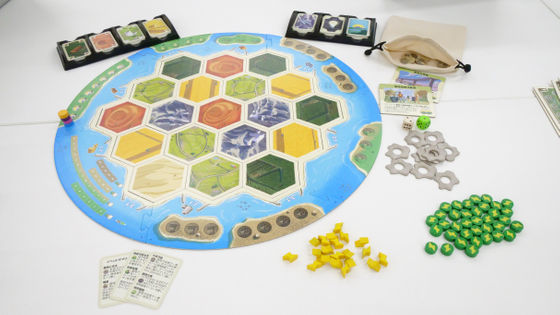
Each player places a village piece, a road piece, a research city piece, a brown power plant piece, a green power plant piece, and a warehouse tile on their personal board.

Place one green event chip face down under each green power plant.

When preparation is complete it looks like this.
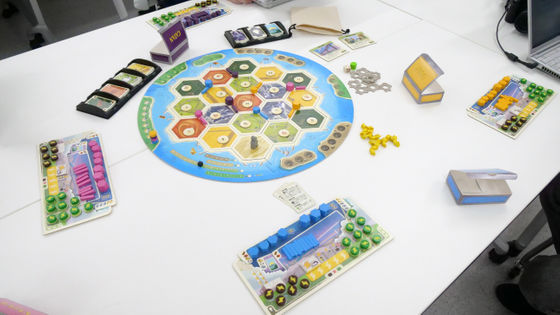
The basic gameplay is the same as in traditional Catan, with players rolling two dice on their turn and using the resources they obtain to build and expand their town. The player who reaches 10 victory points at the end wins. However, unlike traditional Catan, if the bag of event chips is empty and environmental pollution on Catan Island becomes serious, the game ends even before the victory points reach 10. In that case, the player with the largest difference between the green power plant and the brown power plant they have built wins.
In Catan Energy Edition, players play three phases in sequence each turn: the Event Phase, the Income Phase, and the Action Phase. In the Event Phase, players draw the number of event chips from the bag indicated by the position of the pollution level marker on the Environmental Pollution Track.
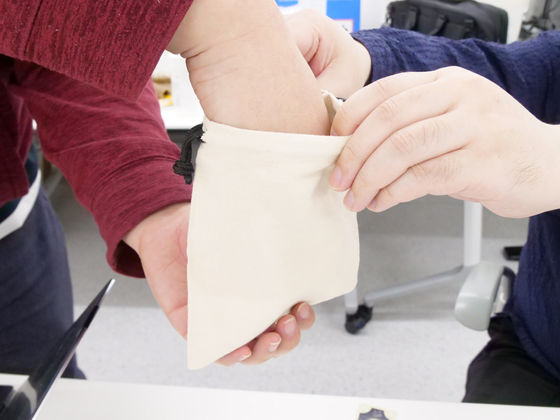
The initial position of the pollution level marker is '12', so the first player will draw one event chip.
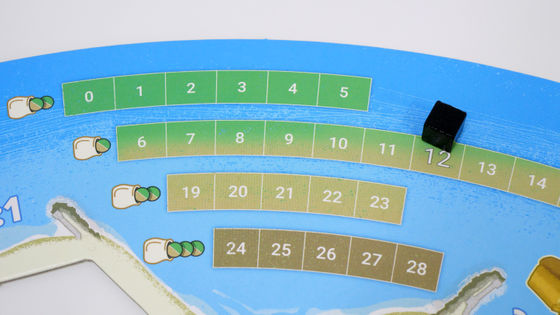
The drawn event chips are placed in the event chip area with the same mark on the sea frame. When all the designated chips are placed in the event chip area, various events will occur.
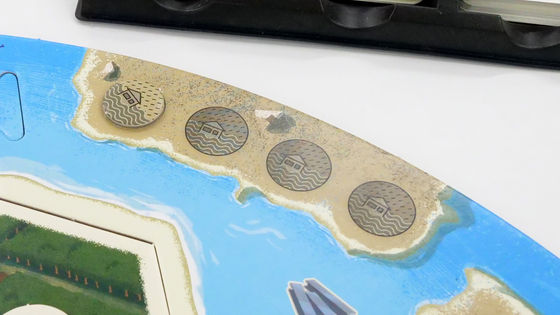
The following 'income phase' is basically the same as the traditional Catan. You roll two dice and can acquire resources from the terrain tile with the number chip corresponding to the total of the dice. This time, the dice number is '3'. Therefore, players who have built a village or research city adjacent to a terrain tile with a '3' number chip can acquire resources.
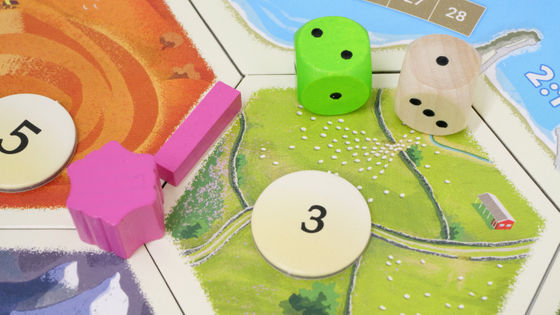
Also, if a player has a research city adjacent to the terrain tile they rolled, they will get a research card in addition to the resource card corresponding to that terrain tile. Research cards are very important because they help them build power plants.
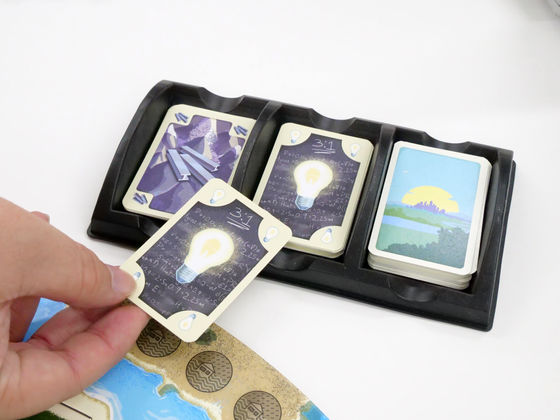
However, sometimes the total of the dice will be 7.
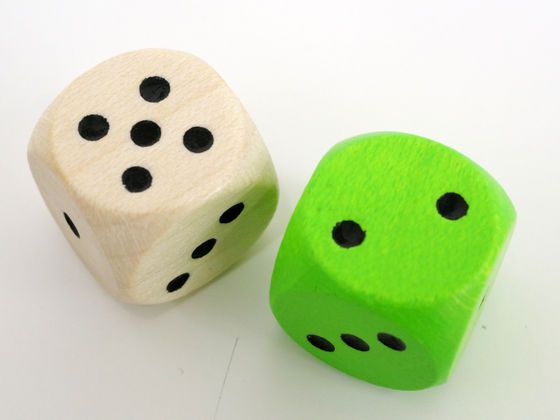
In that case, the player who rolled the 7 can move the Environmental Investigator piece to any position. The location where the Environmental Investigator piece is placed cannot produce resources even if the corresponding number is rolled on the dice. Also, players with 8 or more cards in their hand must return half of them to their stock, and the flow of the game is instantly disrupted by the Environmental Investigator.
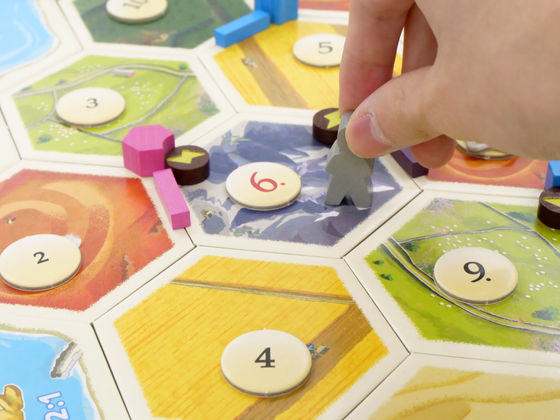
In addition, the player who rolled a 7 can randomly steal one card from one of the other players who has a village or research city piece adjacent to the terrain tile where the Environmental Investigator is placed.
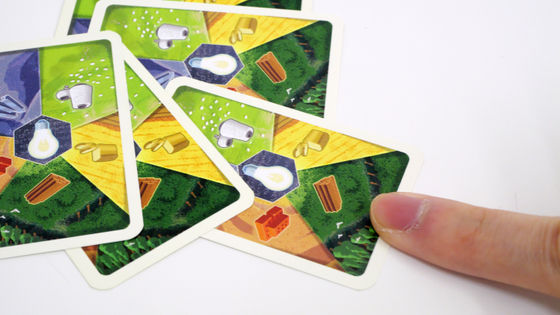
During the 'Action Phase' you can do any of the following three things as many times as possible: 'exchange cards or energy pieces,' 'construct to gain victory points or increase resource production,' and 'purchase to obtain other benefits.'
By building villages, research cities, and power plants, you can increase the number of resource cards you acquire and gain victory points. To build, you pay a specific combination of resource cards or research cards as a cost and place the corresponding pieces from your personal board onto the game board. Power plants are placed in any of the recesses of a village or research city. If you roll a number on the dice that corresponds to the terrain tile on which a power plant is placed, you can acquire an energy piece in addition to resource cards and research cards.
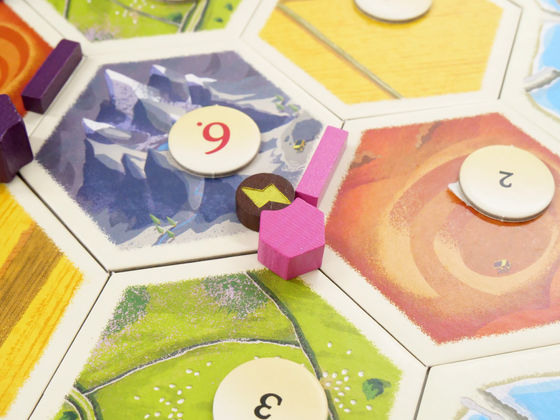
However, building villages, research cities, and brown power plants will increase the amount of environmental pollution. Each '+' mark visible on the personal board will increase the player's environmental pollution level by one. The total of each player's environmental pollution levels will be the position of the pollution level marker on the environmental pollution track, so if you build too many, you will have to draw more chips in the event phase, and the game will end sooner.
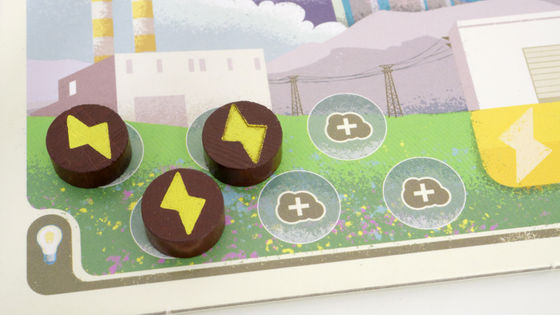
On the other hand, by constructing a green power plant, you can reduce the environmental pollution level by 1 per plant. You can also add green event chips placed under the green power plant piece to your bag, which helps you continue the game. Green power plants are more expensive to build than brown power plants, but they can contribute to the environment.

In 'Purchases to obtain other benefits,' you can pay a specified cost, such as energy pieces or resource cards, to acquire a 'warehouse' that increases the number of cards in your hand that cannot burst to 10, or your choice of resource cards, research cards, or development cards.
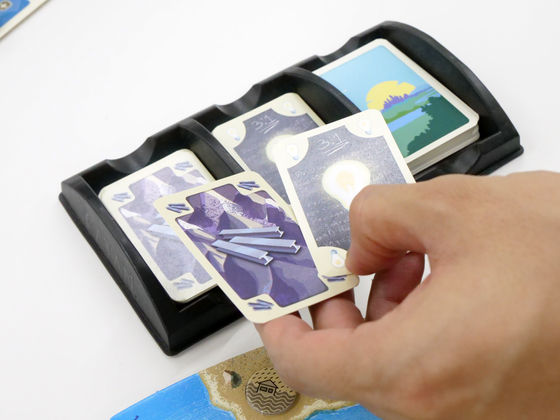
You can play only one development card per turn during your turn, and some cards directly affect victory points.
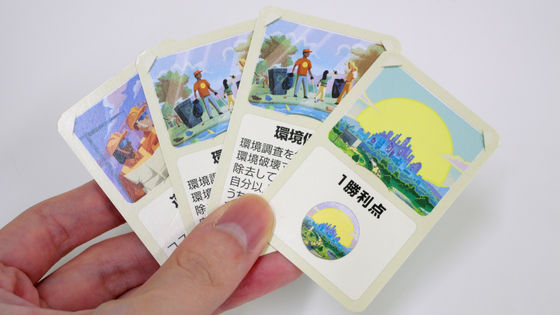
As the game progresses, all of the brown event chips for 'environmental disaster' are placed on empty spaces. In this case, an event will occur immediately. The event that will occur is listed on the event summary card.

In the 'Environmental Disaster' event, the active player must roll the dice and place an environmental destruction marker on all number chips that correspond to the result. Villages, research cities, and number chips with an environmental destruction marker placed on them cannot acquire resource cards, research cards, or energy pieces until the marker is removed. Note that the environmental destruction marker can only be removed if the corresponding number is rolled and no income is earned, if one energy piece is used in the action phase, or if the development card 'Environmental Protection' is played.
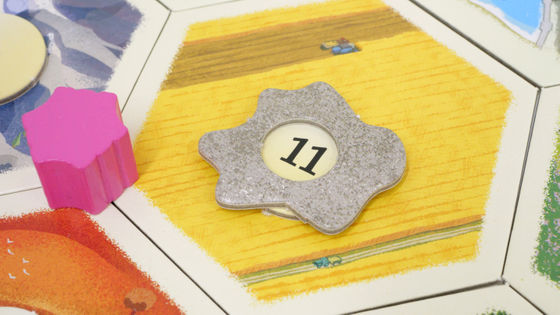
As the game progresses, villages, research cities, and brown power plants begin to pop up in abundance.
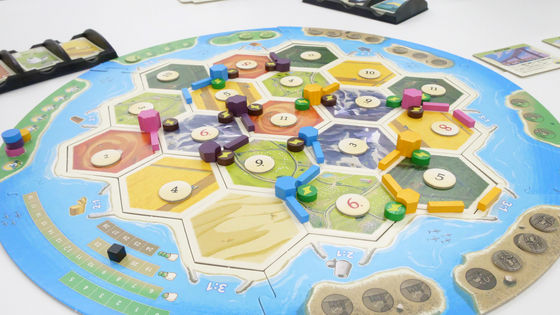
The pollution level marker on the pollution track also reached 22, and players were required to draw two event chips from the bag, which resulted in the number of event chips in the bag rapidly decreasing.

Players who fear the game will end early will try to prevent the bag of event chips from running out by exchanging resource cards with each other and building green power plants, and will cooperate to continue the game. As with traditional Catan, players can freely trade in 'Catan: Energy Edition,' so sometimes large-scale trades such as '3 metal cards and 1 brick card for 1 research card' are made.
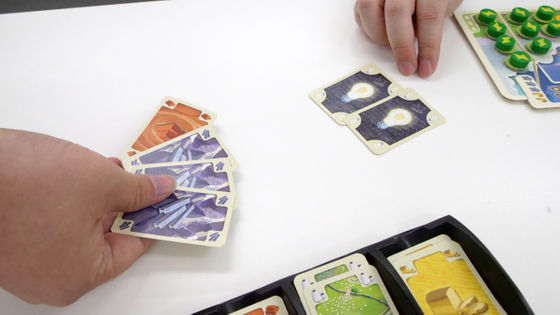
The tightrope walk continues as you build a green power plant, add green event chips to the bag, and somehow make it to the next turn.
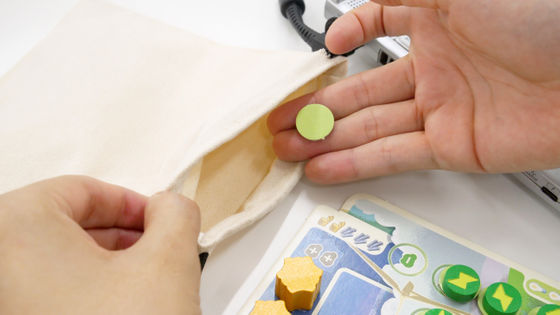
In the end, the yellow player won by contributing to the environment while building villages and research cities, and successfully reaching 10 victory points.

My impressions after playing the game were that it was fun because, unlike traditional Catan, it was not all about competition, but rather involved the need to cooperate with other players to protect the environment. The key point is that it is difficult to win early by playing without contributing to the environment, as there are victory conditions such as 'when all chips are empty, the player with the greatest difference between the green and brown power plants wins.' In addition, the game has been made as much as possible to eliminate the drawbacks of traditional Catan, such as 'being heavily dependent on the roll of the dice' and 'it is difficult to catch up with or turn around a player ahead of you.' Although the rules are complicated, it is a very exciting game to play.
'Catan Energy Edition' will be released on December 18, 2024, and the suggested retail price will be 13,200 yen including tax.
Related Posts:







